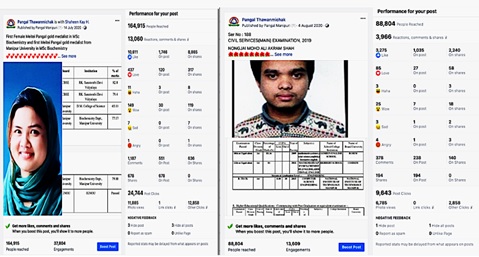Facebook an Anti-Stereotyping Tool: A Case Study

DOI:
https://doi.org/10.54060/JIEEE/002.02.012Keywords:
Social media, stereotyping, sentiment analysis, pangal, social changeAbstract
Facebook, the most popular social media (SM) platform has penetrated every nook and corner of the world. SM is now treated as the ‘fifth Estate’, other than legislative, executive, judiciary, and mainstream media. The power of SM as a critique is widely acknowledged. Establishments are finding it difficult to deal with it at times. Due to its ease of usage and relative anonymity, the general public finds it very convenient to put across their viewpoints, even if it’s against the establishment. Some establishments at times are at loggerheads with champions of freedom of speech including civil rights activists. SM has been used for propaganda, marketing, and awareness campaigns. In this paper, we are proposing to use this powerful tool towards social change. Through a case study, a detailed process is being proposed for using social media particularly Facebook as an anti-stereotyping tool. The response to an online survey, the outcome of opinion min-ing, and the enthusiastic response to our case study by the targeted audience validate our hypothesis that Facebook can be effectively utilized as an anti-stereotyping tool.
Downloads
References
J. A. Barnes, “Class and committees in a Norwegian island parish,” Hum. Relat., vol. 7, no. 1, pp. 39–58, 1954.
B.-S. Jong, C.-H. Lai, Y.-T. Hsia, et al., “An exploration of the potential educational value of Facebook,” Comput. Human Behav., vol. 32, pp. 201–211, 2014.
S. Dixon,” Most popular social networks worldwide,” accessed online, https://www.statista.com/statistics/272014/global-social-networks-ranked-by-number-of-users/, Feb 2021.
K. J. Boyte, "An Analysis of the Social-Media Technology, Tactics, and Narratives Used to Control Perception in the Propaganda War Over Ukraine," Journal of Information Warfare, vol. 16, no. 1, pp. 88-111. JSTOR, www.jstor.org/stable/26502878. Ac-cessed, 2017.
I. V. Dunu, C. E. Uzochukwu, "Social Media: An Effective Tool for Social Mobilization in Nigeria." Vol.20, no.4, pp.10-21, 2015.
F. Ahamed,” Manipuri Muslims Historical Perspectives,” Pharos Media, First Edition, pp.1-192, 2011.
K. A. Ali, "Manipur at a Glance an Ethnics Dilemma Part 2,” e-pao.net. http://e-pao.net/epSubPageExtractor.asp?src=education.Scientific_Papers.Manipur_at_a_Glance_An_Ethnics_Dilemma_Part_1_By_Khulakfam_Altab_Ali, pp.1-12.
A. Alam, https://www.sabrangindia.in/article/meitei-nationalist-dystopia-and-perils-anti-muslim-prejudice-manipur. sabrangindia. in Retrieved, Jan 2021.
Chitra Ahanthem, "How mob justice in Manipur was given a communal tone". Rediff. Retrieved 2015.
H. Mander,"Lynching of young Muslim entrepreneur in Manipur last year shows such acts are carefully planned". Scroll.in. Scroll India, September 2019.
S. Haripriya, "Marginalised within margins." News 18 Blog. Retrieved 21 Feb. 21.
W. W. Goh, J. L. Hong, and K. S. Goh, “Students’ behavior and perception of using Facebook as a learning tool,” in 8th International Conference on Computer Science & Education, pp. 731-736, 2013.
K. K. Kapoor, K. Tamilmani, N. P. Rana et al., “Advances in social media research: Past, present and future,” Inf. Syst. Front., vol. 20, no. 3, pp. 531–558, 2018.
A. O. AI-Youbi, A. Al-Hayani, H. J. Bardesi, et al., “The King Abdulaziz University (KAU) Pandemic Framework: A methodological approach to leverage social media for the sustainable management of higher education in crisis,” Sustainability, vol. 12, no. 11, p. 43-67, 2020.
H. Chiroma, N.L.M. Shuib, I. Adamu, et al., “Advances in teaching and learning on Facebook in higher institutions,” IEEE Access, vol. 5, pp. 480–500, 2017.
M. Tye, C. Leong, F.T.C. Tan, et al. "Social Media for Empowerment in Social Movements: The Case of Malaysia's Grassroots Activism," Communications of the Association for Information Systems: Vol. 42, no.1, pp.408-430, 2018.
Y. Hou and C. Lampe, “Social media effectiveness for public engagement: Example of small nonprofits,” in Proceedings of the 33rd Annual ACM Conference on Human Factors in Computing Systems, 2015.
A. Moitra, A. Kumar, & A. Seth, “An analysis of community mobilization strategies of a voice-based community media plat-form in rural India,” Information Technologies & International Development, vol.14, pp.116-133, 2018.
T. T. Nguyen and A. G. Kravets, “Analysis of the social network facebook comments,” in 7th International Conference on Information, Intelligence, Systems & Applications (IISA), pp. 1-5, 2016.
E. J. Villota and S. G. Yoo, “An experiment of influences of Facebook posts in other users,” in International Conference on eDemocracy & eGovernment (ICEDEG), pp. 83-88, 2018.
W.-H. S. Tsai and L. R. Men, “Motivations and antecedents of consumer engagement with brand pages on social networking sites,” J. Interact. Advert., vol. 13, no. 2, pp. 76–87, 2013.
C. J. Hutto, & E.E. Gilbert,” VADER: A Parsimonious Rule-based Model for Sentiment Analysis of social media Text,” Eighth International Conference on Weblogs and Social Media (ICWSM-14). Ann Arbor, MI, vol.8, no.1, pp.216-225, June 2014.



























